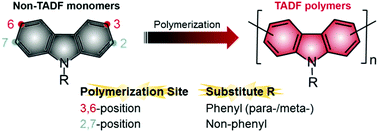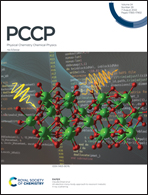Constructing high-performance TADF polymers from non-TADF monomers: a computational investigation†
Abstract
Thermally activated delayed fluorescence (TADF) polymers excelling in simple, low-cost and large-area solution process ability have attracted tremendous attention recently, but it remains a great challenge for the design of such materials due to the lack of reliable molecular construction guidelines. Here we perform a systematic computational investigation on the construction of TADF polymers from non-TADF monomers to elucidate the effects of polymerization sites, substituent positions and substituent types. The results indicate that the polymerization of 3,6-carbazole-based monomers with different substituents is efficient to build TADF polymers due to their facile π-conjugation extendability. Especially, polymers with para-phenyl-substituted monomers are promising in light of their separated frontier molecular orbitals for small ΔEST with favorable energy levels, bipolar charge transport properties and relatively strong absorption/emission intensity, which should be highly attractive for experimental investigations. These findings and insights are important in revealing the structure–property relation of TADF polymers made from non-TADF monomers with important clues for understanding the construction mechanism and molecular design principles of TADF polymers.



 Please wait while we load your content...
Please wait while we load your content...